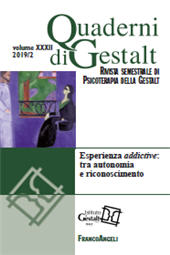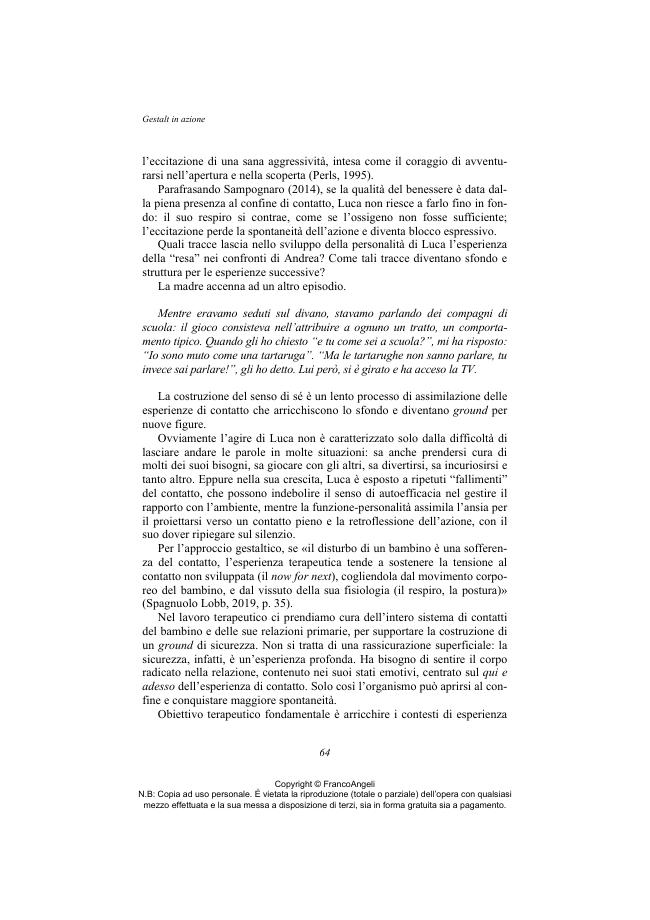Silenzi tra parole sospese : iil mutismo selettivo nella prospettiva gestaltica
51-77 p.
L'articolo propone una riflessione sul mutismo selettivo e ne traccia un possibile percorso di intervento psicoterapeutico, coerente con i principi della psicoterapia della Gestalt. Il lavoro prende spunto dall'esperienza del mutismo di un bambino di cinque anni e del suo contesto relazionale, familiare e scolastico. Dopo un breve profilo diagnostico e la descrizione di alcune tipiche modalità comunicativo-relazionali, seguono cenni sulle chiavi di lettura elaborate dai principali approcci psicoterapeutici e sulle molteplici variabili (biologiche, psicologiche e relazionali) che sembrano coinvolte in un modello eziologico multifattoriale. Si suggeriscono poi alcune coordinate teorico-metodologiche che possono guidare il progetto di cura:.
- Il mutismo selettivo è inteso come parte di un "campo" fenomenologico-relazionale; - I sintomi sono riletti nella dimensione olistica dell'esperienza corporea e nella loro funzione regolativa e adattiva; - Si fa riferimento al processo di contatto per sottolineare le modalità con le quali si esprime il mutismo nella reciprocità di un'interazione; si evidenziano gli aspetti disfunzionali e soprattutto le risorse nell'esperienza del bambino e del caregiver. La traccia per il progetto psicoterapeutico si articola tenendo conto del concetto di "conoscenza relazionale estetica" (Spagnuolo Lobb, 2017) e del modello dei "passi di danza" (Spa-gnuolo Lobb, 2016), così come elaborati dall'Istituto di Gestalt HCC Italy. [Testo dell'editore].
This article proposes a reflection on the selective mutism and traces a possible path of psychotherapeutic intervention, consistent with the principles of Gestalt psychotherapy. The work takes its cue from the experience of the muteness of a five-year-old child and his relational, family and school context. After a brief diagnostic profile and the description of some typical communicative-relational modalities, a few hints on the toughts elaborated by the main psychotherapeutic approaches follow, and on the multiple variables (biological, psychological and relational) that seem to be involved in a multifactorial etiological model.
Then some theoretical-methodological frames are suggested, aimed to guide the therapeutic project: - Selective mutism is understood as part of a phenomenological-relational "field"; - The symptoms are seen in the holistic dimension of the bodily experience and in their regula-tory and adaptive function; - Finally, reference is made to the contact process to underline the ways in which the mutism is expressed in the reciprocity of an interaction; we highlight the dysfunctional aspects and especially the resources in the experience of the child and the caregiver. The trace for the psychotherapeutic project is divided into three parts: - The intervention with family members, with a starting point for a phenomenological observation of the reciprocity between child and parent (we refer to the model of "dance steps", developed by the Institute of Gestalt HCC Italy) and a nod to some themes present in the family with selective mutism;.
- The second area of the intervention proposes some indications on the therapeutic relationship with the child, suggesting a particular attention to the intersubjective dimension (which en-hances the therapist's resonance skills through an aesthetic relational knowledge) and to the child's ability to attune and synchronize; - Finally, some topics that can accompany the experience of the child with selective mutism at school are presented, and some guide lines for a collaboration between psychotherapist and teachers are suggested. [Publisher's text].
-
Articles du même numéro (disponibles individuellement)
-
Informations
Code DOI : 10.3280/GEST2019-002004
ISSN: 2035-6994
DISCIPLINES
KEYWORDS
- Mutismo selettivo, freezing, conoscenza relazionale estetica, osservazione fenomenologica della relazione
- Selective mutism, freezing, aesthetic relational knowledge, phenomenological observation of the relationship



